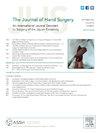手部畸形初次重建后的翻修手术
IF 2.1
2区 医学
Q2 ORTHOPEDICS
引用次数: 0
摘要
目的:蹼蠕变和瘢痕挛缩是并指畸形重建的既定并发症;然而,很少有报道描述翻修手术的风险因素。本调查旨在研究先天性手畸形再手术的比例和风险因素:方法:对 2007 年至 2021 年期间在一家儿童医院接受并指畸形重建手术的患者进行回顾性研究。随访时间不足一年的病例被排除在外。每个网络空间都记录了人口统计学、手术和结果数据,以考虑混合治疗的情况:共对 231 名儿童的 514 个蹼间隙进行了回顾性研究,初次重建后的平均随访时间为 6.0 年;51 名儿童(22.1%)的 66 个蹼间隙(12.8%)进行了翻修。最常见的手术是因蹼蠕变而进行的蹼间隙加深(57.9%的病例)和数字瘢痕挛缩松解(45.6%);少数病例(17.5%)通过其他美学/功能性手术增加了蹼间隙。翻修发生在初次重建后的中位 1.7 年。第一蹼间隙(拇指-食指)最常发生再次手术(33.3%)。在多变量分析中,第一蹼间隙受累、完全联合畸形和初次重建后的并发症会显著增加翻修的几率。初次重建时的年龄不是重要的预测因素。翻修后,10.5%的病例出现复发性蹼间隙蠕变,14.0%的病例出现复发性瘢痕挛缩。7名儿童(3.0%)中的8个(1.6%)蹼间隙需要多次翻修:结论:约有13%的联合畸形重建手术(22%的患者)需要再次手术。大多数翻修手术发生在初次重建后的 4 年内。完全性联合畸形、初次重建后的并发症和第一蹼间隙受累会增加翻修的风险;初次重建时的年龄不是风险因素。翻修手术的结果与指数手术相同,10%到14%的翻修蹼间隙会出现复发性蹼蠕动或挛缩:治疗四级。本文章由计算机程序翻译,如有差异,请以英文原文为准。
Revision Surgery Following Primary Reconstruction for Hand Syndactyly
Purpose
Web creep and scar contracture are established complications of syndactyly reconstruction; however, few reports characterize risk factors for revision surgery. The purpose of this investigation was to examine the rate and risk factors of reoperation for congenital hand syndactyly.
Methods
Patients undergoing syndactyly reconstruction from 2007 to 2021 at a single children’s hospital were reviewed. Cases with less than 1 year of follow-up were excluded. Demographic, surgical, and outcomes data were recorded by each web space to account for mixed treatments.
Results
In total, 514 web spaces in 231 children were reviewed with a mean follow-up of 6.0 years after primary reconstruction; 66 (12.8%) web spaces in 51 (22.1%) children underwent revision. The most common procedures were web space deepening due to web creep (57.9% of cases) and digital scar contracture release (45.6%); these were augmented in a minority (17.5%) of cases by other aesthetic/functional procedures. Revisions occurred at a median of 1.7 years after primary reconstruction. First web spaces (thumb–index finger) were most frequently reoperated (33.3%). On multivariable analysis, first web space involvement, complete syndactyly, and complications after the primary reconstruction significantly increased odds of revision. Age at primary reconstruction was not a significant predictor. Following revision, 10.5% of cases had recurrent web creep, and 14.0% had recurrent scar contracture. Eight (1.6%) web spaces in seven (3.0%) children required multiple revisions.
Conclusions
Approximately 13% of syndactyly reconstructions (22% of patients) require reoperation. Most revisions occur within 4 years of primary reconstruction. Complete syndactyly, complications after the primary reconstruction, and first web space involvement increase the risk of revision; age at primary reconstruction is not a risk factor. Revision outcomes mirror the index procedure, with 10% to 14% of revised web spaces experiencing recurrent web creep or contracture.
Type of study/level of evidence
Therapeutic IV.
求助全文
通过发布文献求助,成功后即可免费获取论文全文。
去求助
来源期刊
CiteScore
3.20
自引率
10.50%
发文量
402
审稿时长
12 weeks
期刊介绍:
The Journal of Hand Surgery publishes original, peer-reviewed articles related to the pathophysiology, diagnosis, and treatment of diseases and conditions of the upper extremity; these include both clinical and basic science studies, along with case reports. Special features include Review Articles (including Current Concepts and The Hand Surgery Landscape), Reviews of Books and Media, and Letters to the Editor.

 求助内容:
求助内容: 应助结果提醒方式:
应助结果提醒方式:


